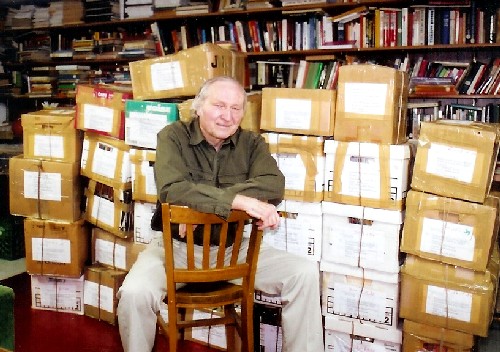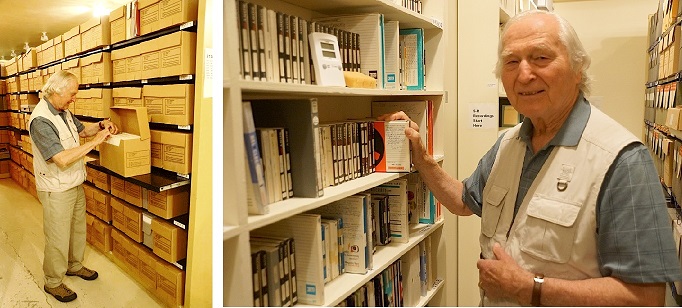Tarasoff Papers
Koozma Tarasoff fonds (F 370): 1882-2004, 64.06 m textual records, plus sound recordings, maps, photographs, and other media types
Photo of me in my home, June 1, 2004 with a number of files that I was about to send off to the Saskatchewan Archives. At that time, I sent off the following note to the Archives:
The 34 boxes of materials
consist of correspondence, files, reports, [audio
recordings and transcriptions], select journals, and books
on the themes established earlier in my collection:
Doukhobors, Canadian Indians and Metis, Ethnic Studies and
Multiculturalism, Community Development (including
Communications, Adult Education, and Applied
Anthropology), East-West Bridge-building, and the Peace
Movement. These are items that I have been personally
involved in over several decades.
The archives then sent out this news release about my donation.
December 1995
Saskatchewan Archives Board In 2020 all archives consolidated in Regina
Google map: Provincial Archives of Saskatchewan
University of Saskatchewan
3 Campus Drive
Saskatoon, Canada S7N 5A4
University of Regina
Regina, Canada 545 0A2
NEWS
RELEASE
A major collection has recently been prepared for research use in the Saskatoon office of the Saskatchewan Archives Board. The Koozma J. Tarasoff Papers* were donated in 1994, and have been processed in time for two major Doukhobor anniversary celebrations: the 1995 centennial of the burning of firearms in Russia [1895] and the 1999 centennial of the Doukhobor migration to Canada. Tarasoff's grandfather participated in the "burning of firearms" and joined the first large migration of Doukhobors to Saskatchewan. The Tarasoff family became Independent Doukbobors [edinolichniki] who farmed near the community of Pokrovka in the Eagle Creek district, before moving to Saskatoon so that their sons could continue their education. [* Also called Koozma Tarasoff fonds (F 370): 1882-2004, 64.06 m textual records, plus sound recordings, maps, photographs, and other media types]
An ethnologist by occupation, Tarasoff's research into Doukhobor history has been extensive and in-depth; consequently, his research materials cover a full range of related topics, in both English and Russian. The Tarasoff Papers contain a wealth of information about the history of Doukhobors in Canada, particularly in Saskatchewan and in the Kootenay area of British Columbia. Tarasoff has gathered materials which tell the story of Doukhobor leadership in Canada, with particular attention given to the controversial Verigin dynasty. He has documented the beliefs and activities of the many groups and organizations which developed within Doukhobor society during the last century. The nature of Doulthobor religion and culture including pacifism, a major tenet of Doukhoborisrn is examined, and Tarasoff's continuing involvement in the peace movement is recorded. Along with research notes. correspondence, speeches, photographs and published materials, the Tarasoff Papers include newspaper clippings about Doukhobors in Canada in both English and Russian dating from 1935 to 1994, hundreds of hours of oral history interviews, and dozens of sound recordings of Doukhobor music, celebrations, conventions, speeches and lectures, and peace events.
While the Tarasoff Papers were being arranged and described, it became increasingly apparent that the Doukhobor records were not the only materials of significant research value. Tarasoft also donated records he created while working for departments of the Saskatchewan and Canadian governments which were responsible for rural development. Close examination has revealed that these papers contain valuable information pertaining to indigenous peoples in Canada, and to rural and community development in Western Canada in the late 1960s and the 1970s. For example, the working papers for a study Tarasoff conducted for the Saskatchewan Department of Social Welfare in the 1960s entitled 'The Pipestone-QuAppelle Valley Resources Potential and Human Relations ARDA Study' contain a comprehensive analysis of both native and non-native communities in the Broadview area.*
* This grant was listed in: Inventory of Research on Adult Human Resource Development in Canada. Canadian Dept. of Regional Economic Expansion, Ottawa, 1963, page 4, as 'Pipestone-Qu'Appelle Valley Resources Potential and Human Relations Study (0112)'. By Saskatchewan Department of Welfare, and Saskatchewan Department of Agriculture. Principal Investigators: A. H. Zimmerman, and K. J. Tarasoff. To conduct an attitudinal and resource potential survey of local towns and villages; to gather basic ethnological data of the Native Indians in the area, together with respect to grain growing, cattle raising, irrigation, market gardening and the tourist industry; to form a basis for amicable adjustment to social change. (1965-1967).
The research was announced: 'Resources study to be undertaken On Indian reserves', The Leader-Post, Regina, Sask., December 2, 1964, page 2.

Map, not in news release, showing
tribes surveyed.
As a final note of interest, the Tarasoff Papers include a series of letters written to Koozma by baseball great Ty Cobb. Alter meeting at a baseball camp in the United States, Cobb and Tarasoff corresponded for a few years in the early 1950s. Cobb filled his letters with helpful training tips for the young baseball player, and arranged a try-out for Tarasoff with a California ball team. [See: "The sweet side of Ty Cobb", from The Ottawa Citizen and The Saskatoon Star-Phoenix, December 26, 2004.]
More about contacting the Saskatchewan Archives.
Photos taken July 2015 of me examining my archived documents and tapes.
